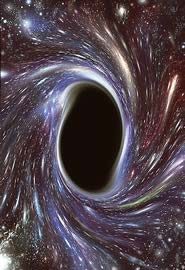Event horizon dawns on desktop

A black hole: physicists hope to mimic this peculiar cosmic phenomenon in the lab. <br>© SPL <br>
Miniature physics phenomena could show hidden shades of space.
An event horizon is dawning in laboratories. Using frozen light, physicists hope to mimic this peculiar cosmic phenomenon and glimpse something like the belches of a black hole.
At the event horizon – the rim of a voracious black hole – dimensions as we know them disappear. To an observer on a spaceship, light and time appear to stand still. A floating spaceman would seem to slow and stop.
“It’s very difficult to do experiments at real black holes,” points out physicist Ulf Leonhardt of the University of St Andrews in Scotland. So Leonhardt has worked out a way to build a simulated event horizon using a device that halts light in the lab1. “It would be almost table-top sized,” he says.
The simulation could create a mock version of elusive ’Hawking radiation’. These weak electromagnetic waves are thought to occur when light reaches the event horizon, but they are masked from us by other emissions. “We might even be able to see it with the naked eye,” says astronomer Fulvio Melia of the University of Arizona in Tucson.
No one has ever seen Hawking radiation, or knows what it will look like. The sum of the Universe’s light equals a pale turquoise, it was revealed last week Hawking radiation, too, “might have a particular tint”, suggests Melia.
“If it’s true it’s tremendously interesting,” says cosmologist Bernard Carr of Queen Mary and Westfield College, London. Imitation event horizons may help us to understand the quantum effects of gravity, and resolve conflicts between general relativity (the theory of the biggest bodies in the Universe) and quantum theory (the rules governing its tiniest constituents).
General relativity predicts that nothing can escape a black hole; quantum theory says that Hawking radiation does.
On the horizon
Black holes are formed when ancient stars collapse under their own gravity. They pack vast mass into a pinpoint of space. Their intense gravity sucks in anything that passes too close, including light; they even distort time.
As light waves hit the event horizon, they are thought to split into pairs of particles called ’quanta’; one falls into the black hole and one escapes as Hawking radiation. “A pile-up occurs,” says Melia. Many light waves produce streams of quanta heading forwards and backwards.
Leonhardt’s idea is to copy this barrier, using the recent demonstration that certain materials can halt light2,3,4. Shining a laser beam into cold matter manipulates the rate that its constituent atoms absorb and re-emit waves of a second beam, causing this second beam to slow or stop.
The point where light stands still is analogous to an event horizon, says Leonhardt: quanta will be emitted. The simulation is a ’naked horizon’: a membranous event horizon without the black hole beyond.
References
- Leonhardt, U. A laboratory analogue of the event horizon using slow light in an atomic medium. Nature, 415, 406 – 409, (2002).
- Turukhin, A. V. et al. Observation of ultraslow and stored light pulses in a solid. Physical Review Letters, 88, 023602, (2002).
- Liu, C., Dutton, Z., Behroozi, C. H. & Hau, L. V. Observation of coherent optical information storage in an atomic medium using halted light pulses. Nature, 409, 490 – 493, (2001).
- Phillips, D. F., Fleischhauer, A., Mair, A & Walsworth, R. L. Storage of Light in Atomic Vapor. Physical Review Letters, 86, 783 – 786, (2001).
Media Contact
All latest news from the category: Physics and Astronomy
This area deals with the fundamental laws and building blocks of nature and how they interact, the properties and the behavior of matter, and research into space and time and their structures.
innovations-report provides in-depth reports and articles on subjects such as astrophysics, laser technologies, nuclear, quantum, particle and solid-state physics, nanotechnologies, planetary research and findings (Mars, Venus) and developments related to the Hubble Telescope.
Newest articles

“Nanostitches” enable lighter and tougher composite materials
In research that may lead to next-generation airplanes and spacecraft, MIT engineers used carbon nanotubes to prevent cracking in multilayered composites. To save on fuel and reduce aircraft emissions, engineers…

Trash to treasure
Researchers turn metal waste into catalyst for hydrogen. Scientists have found a way to transform metal waste into a highly efficient catalyst to make hydrogen from water, a discovery that…

Real-time detection of infectious disease viruses
… by searching for molecular fingerprinting. A research team consisting of Professor Kyoung-Duck Park and Taeyoung Moon and Huitae Joo, PhD candidates, from the Department of Physics at Pohang University…





















